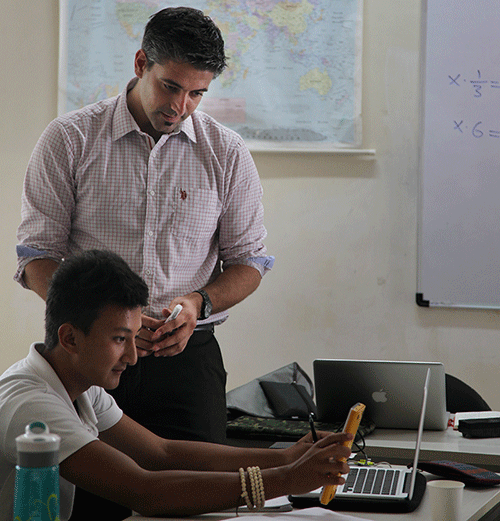As I write this, I'm waiting for our students to return from their weXplore, a five-day excursion that takes students beyond their host city for immersive cultural experiences. For the past two months, we as a school have called Maun, Botswana, our home. It's a small town on the edge of the Okavango Delta and, for many travelers, a doorway into Africa. But Maun is only one perspective, and it...
Read MoreAt TGS, like at most high schools, there is no shortage of students with the capacity to understand mathematical concepts when the conditions are ideal — trust me here. But what about when the conditions for learning aren’t particularly conducive? As a traveling school, we find ourselves in unique locations on a regular basis, and classrooms in Peru pose a completely different learning environment than a classroom in Sweden. Not all teachers travel, but all teachers find themselves in situations where a strategy can be implemented to help alleviate student confusion.
During my career, the main reasons why a student may not understand an aspect of mathematics can be categorized into one of the five following reasons.
#1 Bad Prof!
The teacher explained the idea poorly: context not provided, insufficient examples, illustrations, or an excess of speed.
- Symptoms: more than one student will be confused, often a significant number.
- Strategy / Approach: a student should let the teacher know that a repeat, rewording, or further illustration may be helpful as the idea is still unclear.

Sydney listens in
#2 Google Translate Anyone?
Perhaps some of the vocabulary was not introduced properly before it was used, or students are unfamiliar due to a different international/cultural background.
- Symptoms: most students show confusion if the teacher failed to introduce vocabulary appropriately, or a small number of students show confusion if a word has been assumed to be understood but different past experiences in students reveal a gap somewhere.
- Strategy / Approach: students must immediately ask so that the consequences of the vague terminology don’t spread any further. Time is of the essence in this case -keyword- immediate!
#3 Squirrel!
The student was not listening properly due to being distracted by an internal or external factor. Sometimes, even when a student is trying to be attentive, the right attitude is not present and the chain of connections attempted by the teacher was lost somewhere. This can very easily happen, and has happened to me more times than I can count — and I can count pretty well!
- Symptom: a single student or small number will be confused / a little lost – often asking a friend nearby for help. This is one of the most delicate and important situations, and needs to be solved artfully. First of all, the student feels an increased guilt at feeling like other students “got it” but they didn’t. This makes them less likely to ask the teacher for help. Secondly, if the explanation is still going, they may distract their friend, causing secondary confusion.
- Strategy / Approach: The correct strategy here (and for this, each student in the class must make a commitment to the rest of the class that they will try to be mindful of this) is for the student to put their hand up and say something along the lines of – I’m sorry I missed a step somewhere between x and y – can you go over it for me?
If the teacher is “on a roll” and other students are engaged, the student should wait until the end of that segment and then stop the teacher — this is key. Another few segments down the line, the teacher may get frustrated that they were not stopped sooner. So what? The teacher will get over it – but if you can avoid it, all the better, na?

Guillermo helps with an assignment
#4 Shaky Foundations
The ideas discussed here are based on a previous mathematical concept being shaky for one or more students.
- Symptom: a deeper worry in the student – this is highly concerning as it gives the student the feeling that they are in a lot of trouble, since there is a piling up of rusty or confusing material.
- Strategy / Approach: this requires a separate conversation with the teacher. This is perhaps the most important responsibility of the student. They need to take control of their learning and start a dialogue which they will have to chase until they feel the previous concept has been covered to their satisfaction.
For a student to simply state “I’m not very good at quadratics” and then hope for the teacher to provide all the required material and time for them to cover the knowledge gap is insufficient and wishful thinking. There needs to be a deliberate, ongoing conversation. This is where many students become complacent and damage their enjoyment and progress in the subject significantly.
Granted, in an ideal world the sole mention of a shaky foundation will trigger the teacher into a sequence of actions that will help the student overcome their gap in full. But with all the things going on in the head of the teacher, this is a little unrealistic, and with him being human and all, the effort needs to be two sided. Much of this may happen, especially at TGS, outside of class time. This means time needs to be scheduled — often one single session will suffice for a gap, other times a little more is needed.
#5 Sleepy Panda
The student was exhausted for reasons x,y,z. Tired at school? How come, surely not! This one is key, guys.
- Symptom: the student may become frustrated or have grumpy reactions to the efforts by their teacher to animate them; may become negative and/or stubborn. Otherwise, student may seem totally disconnected, withdrawn or absent.
- Strategy / Approach: encourage the student to get sleep. Help them understand their limits, and the fact that life is way more joyful and plentiful when they are rested. Let them know their tiredness can affect others around them.
Secondly, the student should let the teacher know at the beginning of the class that they are tired, so the teacher can be mindful, a little more tactful, and patient. This will really help and potentially make the student less grumpy, as they no longer need to hide or get defensive about their tiredness. We all get exhausted from time to time. A second session can be arranged outside of class when the student’s feeling better, or another student may be able to lend a hand after class. Perhaps the student ought to do some quick warm up exercise to oxygenate the body, or take a nap so they are fit and better for the next class – yes, I mean it 🙂
At present, I cannot think of other reasons why a student may be confused about the beautiful subject of mathematics. There is certainly no lack of insight or capacity in a single student I currently teach.
But what about the teacher?
We can be tired, too! That being said, I aim to be well rested each day so that I avoid feeling cloudy and in possession of a grumpy mind.
Commitments for fostering a positive community of maths learners
As an instructor, I hope a couple of positive things come out of your having read this. First, I hope you realize that in order to maintain a healthy community learning environment, you and your students must collaborate to make sure they feel comfortable asking questions and asking each other for help. At the same time, you must be mindful of timing. You cannot explain a key concept without introducing its context, and it shouldn’t be explained at the end of the class, either. Timing, timing, timing.
Students need to be aware of timing, too. Help them choose the right moment for their questions: too late and it will take more work to fix, too early and it may cut into the middle of an argument. It’s important for students to learn this skill. You can direct them and give them feedback — even when they ask impetuously and without regard for timing. If you give them feedback kindly, they will get better at asking, and this will contribute to the flow of the lesson. Often it’s enough to wait for less than a minute for a chain of ideas to reach a “checkpoint” where it’s safe to interrupt.
In all of the above, there is a great deal of emphasis on what the student ought to do, and this is partly because as a teacher it is difficult to perceive every students’ state of understanding.
Closing Notes
As ample research has demonstrated, stress, feelings of shame and inner conflict are the worst possible mental states for a student to be in while learning. I encourage you to foster an open communicative environment, applying creative solutions to the roadblocks you may encounter. If a student knows you are looking for factors that can help them in their learning and not placing the blame for not understanding on their learning capacity, ultimately, they will feel safe to make mistakes and to be adventurous in their thinking, and in their asking.
As teachers, it’s our job to stop these five issues from arising as little as possible by planning activities that are approachable and realistic. I hope this list of frequent reasons for misunderstanding serve you well in your classroom and aids your students in reaching their fullest potential. I chose to share them with my students, and I noticed an improvement in communication and a reduction of feelings of inadequacy circling the classroom.
From time to time, I like to remind my students and myself of the following idea, on which this current post is based: in a relaxed environment, when the teacher uses vocabulary that the students understand, when context is provided, and concepts are layered with no assumptions, the student is likely to succeed in understanding every single time.
-Guillermo Machado, mathematics teacher at THINK Global School